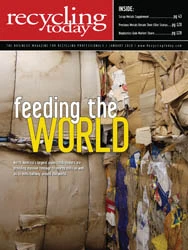Given the huge declines in U.S. construction and auto manufacturing during the past year, the recent rise in ferrous scrap prices may lead many to scratch their heads with surprise.
U.S. raw steel production hit its weekly high for 2008 in the last week of July at 2.14 million tons at a capacity utilization rate of 89.9 percent, according to figures from the American Iron and Steel Institute (AISI), Washington, D.C. Production reached its nadir in the first week of 2009 at 870,000 tons and a capacity utilization rate of 36.3 percent. Despite a recovery to 1.50 million tons of production and a capacity utilization rate of 62.8 percent in the last week of November 2009, the U.S. steel industry is far from the healthy production levels it enjoyed two summers ago.
Why, therefore, have ferrous scrap prices been increasing? World Steel Dynamics (WSD), New York, will attempt to shed some light onto these apparent anomalies.
ON THE RISE
According to analysis by WSD, the following factors contribute to the disconnect in ferrous scrap prices and steel production:
1. The sharp drop in 2009 auto production and reduced overall manufacturing activity had shrunk the supply of prime industrial scrap. As indicated in the accompanying chart, WSD’s index of prime industrial scrap generation for the United States is down from a peak of 21 million metric tons annualized in the summer of 2008 to about 13 million metric tons annualized in November 2009.
2. The unprecedented price spikes in steel and ferrous scrap in 2008 encouraged the aggressive harvesting of obsolete scrap and brought in much of the available “low hanging fruit.” This had once been an easy-to-access inventory for dealers to draw on during price cycle highs. However, 2008’s scrap price explosion has drawn heavily upon these pockets of inventory and has forced dealers to seek more expensive sources of supply. Prices may have to rise even more before it becomes economical to bring in this more difficult-to-harvest scrap.
3. The drop in non-residential construction and the sharp drop in capital expenditures have lessened the need for building demolitions, leading to the subsequent decline in the supply of obsolete scrap.
4. The U.S. dollar has weakened this year. The euro traded below $1.26 in February 2009 and reached a high of $1.51 in November. The U.S. is the world’s largest exporter of ferrous scrap, and a weaker dollar has made U.S. ferrous scrap and all U.S.-dollar-denominated goods even more attractive to foreign buyers.
5. The surge in Chinese steel production in 2009 has driven up the price of pig iron and has boosted China’s scrap imports in its wake.
PREDICTING THE FUTURE
WSD believes that ferrous scrap prices have traditionally been a leading indicator of future steel prices and also a good barometer of imminent changes in economic activity. Ferrous scrap’s seemingly counter-intuitive price behavior demonstrates why it has become the “wildcard” in forecasting finished steel prices.
We see ferrous scrap, along with pig iron and DRI (direct reduced iron), as part of a global bathtub and, unlike finished steel with its strong regional influences, the price of this scrap/pig/DRI bathtub behaves like a truly global commodity. As the world’s largest ferrous scrap exporter, U.S. scrap prices affect the price of finished steel around the world.
WSD has witnessed, on the part of many players in the past year, a growing need to hedge the price risk in steel scrap and finished steel products. Steel users and middleman companies have supported our efforts to create futures markets to meet these needs. Now, we detect a growing interest among the steel mills for a financial solution to ever increasing price uncertainty.
Note: The World Steel Exchange, a joint venture between World Steel Dynamics, New York, and the Chicago Climate Futures Exchange, expects to launch screen-traded futures contracts for U.S. No. 1 busheling scrap, U.S. shredded scrap and U.S. hot-rolled band in the first quarter of 2010.

Explore the January 2010 Issue
Check out more from this issue and find your next story to read.
Latest from Recycling Today
- Nucor receives West Virginia funding assist
- Ferrous market ends 2024 in familiar rut
- Aqua Metals secures $1.5M loan, reports operational strides
- AF&PA urges veto of NY bill
- Aluminum Association includes recycling among 2025 policy priorities
- AISI applauds waterways spending bill
- Lux Research questions hydrogen’s transportation role
- Sonoco selling thermoformed, flexible packaging business to Toppan for $1.8B





